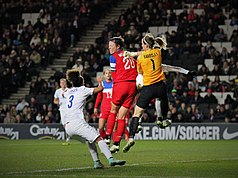Football player
@media all and (max-width:720px){.mw-parser-output .tmulti>.thumbinner{width:100%!important;max-width:none!important}.mw-parser-output .tmulti .tsingle{float:none!important;max-width:none!important;width:100%!important;text-align:center}}
A football player is a sportsperson who plays one of the different types of football. The main types of football are association football, American football, Canadian football, Australian rules football, Gaelic football, rugby league and rugby union.
It has been estimated that there are 250 million association football players in the world,[1] and many play the other forms of football.
Contents
1 Career
1.1 Wages
1.2 Post-retirement
2 Skills
3 Psychological aspects of performance
4 Health issues
4.1 Life expectancy
4.2 Head
4.3 Knee
4.4 Hip
4.5 Muscles
4.6 Sleep and psychological functioning
4.7 FIFA response
5 Lists of players
6 See also
7 References
Career
Jean-Pierre Papin has described football as a "universal language".[2] Footballers across the world and at almost any level may regularly attract large crowds of spectators, and players are the focal points of widespread social phenomena such as association football culture.
Footballers generally begin as amateurs and the best players progress to become professional players. Normally they start at a youth team (any local team) and from there, based on skill and talent, scouts offer contracts. Once signed, some learn to play better football and a few advance to the senior or professional teams.
Wages
Wages in some top men's leagues are significantly higher than other jobs. Players in the Premier League earn average wages of about $1 million per year.[3] In the wealthiest clubs in European football leagues, some players earn an average wage up to $6 to $8 million per year.[4] The best players of those clubs can earn up to $70 million per year.[5]
However, only a fraction of men's professional football players are paid at this level. Wages may be much more moderate in other divisions and leagues, and a significant number[clarification needed] of players are semi-professional. For example, the average annual salary for soccer players in the American Major League Soccer (which started in 2009) for the 2013 season was $148,693, with significant variations depending on player position (goalkeepers for example earned $85,296, whereas forwards earned $251,805[6]).
Popularity and average salaries in women's leagues are far lower. For example, players in the National Women's Soccer League (NWSL) (which started in 2012) earn $15,000 to $40,000 per year as of January 2017.[7]
Post-retirement
Arild Stavrum is a retired football player who post-retirement has worked as a football manager and novelist
Pia Sundhage is a retired football player who post-retirement has worked as the football manager for the United States and Sweden national teams.
A minority of retired footballers continue working full-time within football, for instance as football managers. A 1979 study reported that former first-team ballplayers were over-represented as top ranking executives in their companies and had greater income mobility than second teamers and reserves.[8] However, some experience chronic health issues, see below.
Skills
Psychological aspects of performance
Research shows that association football players that take less than 200ms after the referee blows their whistle for a penalty kick are significantly more likely to miss scoring than those that take over a second.[9][10]
Health issues
Cristiano Ronaldo, an example of a "lean and muscular" men's association football player
Faith Ikidi, an example of a "lean and muscular" women's association football player
An Irish 2002 study of association and Gaelic football players characterised players as "lean and muscular with a reasonably high level of capacity in all areas of physical performance".[11] The opposite is the case for American football, where obesity could be the cause of grave health problems.[12]
A 2000 study documented injuries sustained by Czech [association] football players at all levels:[13]
.mw-parser-output .templatequote{overflow:hidden;margin:1em 0;padding:0 40px}.mw-parser-output .templatequote .templatequotecite{line-height:1.5em;text-align:left;padding-left:1.6em;margin-top:0}
Trauma was the cause of 81.5% of the injuries and overuse was the cause of 18.5%. Joint sprains predominated (30%), followed by fractures (16%), muscle strains (15%), ligament ruptures (12%), meniscal tears and contusions (8%), and other injuries. Injuries to the knee were most prevalent (29%), followed by injuries to the ankle (19%) and spine (9%). More injuries occurred during games (59%) than in practice.
[14]Patellar tendinitis (knee pain) is considered an overused injury that also happens to other athletes of virtually every sport. It is a common problem that football players develop and can usually be treated by a quadriceps strengthening program. Jumping activities place particularly high strains on the tendon and with repetitive jumping, tearing and injury of the tendon can occur. The chronic injury and healing response results in inflammation and localized pain.[15]
Although levels of depression and pain in retired football players are on par with the societal average,[16] some players suffer from post-retirement chronic injuries. Head injuries are a particular concern.
Life expectancy
The average life expectancy or lifespan of an American football NFL player has been reported to be extremely low, only 53 to 59 years depending on playing position.[17] However, a 2012 study reported that retired NFL players have a lower death rate than men in the general population.[18] An oft-cited life expectancy of 58 years has been claimed by Sports Illustrated to be based on a myth.[19] According to a 2007 study, which also claims that little supporting data is available, retired American football players had "long and fulfilling careers with no apparent long-term detrimental effects on physical or mental health scores despite a high prevalence of arthritis".[20] One explanation is that "life expectancy" is ambiguous: it may in some contexts refer to the expected age of death of a player, and in other contexts to the expected remaining number of life years.
As for association football, a 2011 German study found that German national team players live 1.9 years less than the general male population.[21]
Football players participating in international matches for Germany have reduced longevity compared to the general population. This disadvantage was the larger, the earlier the international football player started his international career. This finding is in line with the current knowledge of life expectancy in major athletes, especially those from other team sports
A 1983 study of rugby players found that the life expectancy of All Blacks is the same as for the general population.[22]
Head
Abby Wambach, a retired player known for scoring header goals.
American football players are prone to head injuries such as concussion. In later life, this increases the risk of dementia[23] and Alzheimer's.[24]
Professional American football players self-reporting concussions are at greater risk for having depressive episodes later in life compared with those retired players self-reporting no concussions.[25][26]
Probably due to the repeated trauma associated with heading balls, professional association football has been suggested to increase the incidence of amyotrophic lateral sclerosis.[27] In a 1987 study of former Norwegian association football national team players, one third of the players were found to have central cerebral atrophy, i.e. brain damage.[28] A 1999 study connected soccer to chronic traumatic head injury (CTHI):[29]
[P]articipation in amateur soccer in general and concussion specifically is associated with impaired performance in memory and planning functions. Due to the worldwide popularity of soccer, these observations may have important public health implications
Knee
Anterior cruciate ligaments are particularly vulnerable in most types of football due to injuries that can be sustained during tackles.
Hip
An increased incidence of osteoarthritis in the hip joint has been found in retired football players.[30]
Muscles
A 2012 study of association football injuries found that 19% of all injuries were muscle injuries, of which 54% affected the thigh muscles.[31]
Sleep and psychological functioning
In a 2009 study, association football was found to be associated with favourable sleep patterns and psychological functioning in adolescent male football players.[32]
The rate of suicide among NFL vets has been found to be 59% lower than in the general population.[19]
FIFA response
In 2012, FIFA released a paper intended to identify key risk factors for association football players.[33]
Lists of players
- Lists of association football players
- List of American football players
- List of footballers (Gaelic football)
- Category:Lists of rugby league footballers
See also
- Sports unions
References
^ Rolin, Jack, "football", Britannica Online Encyclopedia.mw-parser-output cite.citation{font-style:inherit}.mw-parser-output q{quotes:"""""""'""'"}.mw-parser-output code.cs1-code{color:inherit;background:inherit;border:inherit;padding:inherit}.mw-parser-output .cs1-lock-free a{background:url("//upload.wikimedia.org/wikipedia/commons/thumb/6/65/Lock-green.svg/9px-Lock-green.svg.png")no-repeat;background-position:right .1em center}.mw-parser-output .cs1-lock-limited a,.mw-parser-output .cs1-lock-registration a{background:url("//upload.wikimedia.org/wikipedia/commons/thumb/d/d6/Lock-gray-alt-2.svg/9px-Lock-gray-alt-2.svg.png")no-repeat;background-position:right .1em center}.mw-parser-output .cs1-lock-subscription a{background:url("//upload.wikimedia.org/wikipedia/commons/thumb/a/aa/Lock-red-alt-2.svg/9px-Lock-red-alt-2.svg.png")no-repeat;background-position:right .1em center}.mw-parser-output .cs1-subscription,.mw-parser-output .cs1-registration{color:#555}.mw-parser-output .cs1-subscription span,.mw-parser-output .cs1-registration span{border-bottom:1px dotted;cursor:help}.mw-parser-output .cs1-hidden-error{display:none;font-size:100%}.mw-parser-output .cs1-visible-error{font-size:100%}.mw-parser-output .cs1-subscription,.mw-parser-output .cs1-registration,.mw-parser-output .cs1-format{font-size:95%}.mw-parser-output .cs1-kern-left,.mw-parser-output .cs1-kern-wl-left{padding-left:0.2em}.mw-parser-output .cs1-kern-right,.mw-parser-output .cs1-kern-wl-right{padding-right:0.2em}
^ jarassé, anne-cécile; yulia, k (30 March 2007). "Jean-Pierre Papin: 'Football is a universal language'". cafébabel. Andrew Burgess (translator).
[permanent dead link]
^ Harris, Nick (20 January 2011). "From £20 to £33,868 per week: a quick history of English football's top-flight wages". Sporting Intelligence.
^ Wages of wealthiest clubs in european football leagues
^ Best football player wages
^ Average wages of soccer players in MLS
^ Linehan, Meg (January 26, 2017). "NWSL minimum salary to double for fifth season". Excelle Sports. Retrieved 10 April 2017.
^ Sack, Allen L.; Thiel, Robert (January 1979). "College football and social mobility: a case study of Notre Dame football players". Sociology of Education. 52 (1): 60–66. doi:10.2307/2112594. JSTOR 2112594.
^ Jordet, Geir; Hartman, Esther; Sigmundstad, Einar (November 2009). "Temporal links to performing under pressure in international soccer penalty shootouts". Psychology of Sport and Exercise. 10 (6): 621–627. doi:10.1016/j.psychsport.2009.03.004. hdl:11250/170599.
^ Football players who rush penalty kicks are less likely to score, 10 September 2009.
^ Strudwick, A.; Reilly, T.; Doran, D. (June 2002). "Anthropometric and fitness profiles of elite players in two football codes". The Journal of Sports Medicine and Physical Fitness. 42 (2): 239–242. PMID 12032422.
^ Korth, Joanne (29 January 2006). "Sports: A huge problem: Strength isn't enough: NFL linemen have to be so big, their health may be at risk". Tampa Bay Times. Times Publishing Company.
^ Chomiak, Jiri; Junge, Astrid; Peterson, Lars; Dvorak, Jiri (September 2000). "Severe injuries in football players: influencing factors". American Journal of Sports Medicine. 28 (s5): s58–s68. doi:10.1177/28.suppl_5.S-58.
^ "Preventing Football Injuries". www.sportsmd.com. Retrieved 16 November 2016.
^ "Patellar Tendonitis - SportsMD". www.sportsmd.com. Retrieved 16 November 2016.
^ Schwenk, T.L.; Gorenflo, D.W.; Dopp, R.R.; Hipple, E. (April 2007). "Depression and pain in retired professional football players". Medicine and Science in Sports and Exercise. 39 (4): 599–605. doi:10.1249/mss.0b013e31802fa679. PMID 17414796.
^ Raley, Dan (8 May 2008). "New NFL goal: A longer life". Seattle pi. Hearst.
^ Bell, Jarrett (8 May 2012). "Study shows NFL players live longer". USA Today. Gannett Company.
^ ab Epstein, David (21 May 2012). "Dead wrong: two studies refute reports in the media about former NFL players' life expectancy". Sports Illustrated. Time Inc.
^ Nicholas, Stephen J.; Nicholas, James A.; Nicholas, Calvin; Diecchio, Jennifer R.; McHugh, Malachy P. (October 2007). "The health status of retired American football players: Super Bowl III revisited". American Journal of Sports Medicine. 35 (10): 1674–1679. doi:10.1177/0363546507302219. PMID 17517907.
^ Kuss, Oliver; Kluttig, Alexander; Greiser, Karin H. (December 2011). "Longevity of soccer players: an investigation of all German internationals from 1908 to 2006". Scandinavian Journal of Medicine & Science in Sports. 21 (6): e260–e265. doi:10.1111/j.1600-0838.2010.01269.x. PMID 21435018.
Pdf.
^ Beaglehole, R.; Stewart, A. (1983). "The longevity of international rugby players". The New Zealand Medical Journal. 96 (735): 513–515. PMID 6578423.
^ Guskiewicz, Kevin M.; et al. (October 2005). "Association between recurrent concussion and late-life cognitive impairment in retired professional football players". Neurosurgery. 57 (4): 719–726. doi:10.1227/01.NEU.0000175725.75780.DD. PMID 16239884.
^ Ritter, Jim (18 July 2011). "Research: Football players may be more vulnerable to Alzheimer's". Loyola University Health System. Archived from the original on 8 December 2011. Retrieved 5 November 2011.
^ Kerr, Zachary Y.; Marshall, Stephen W.; Harding Jr., Herndon P.; Guskiewicz, Kevin M. (October 2012). "Nine-year risk of depression diagnosis increases with increasing self-reported concussions in retired professional football players". American Journal of Sports Medicine. 40 (10): 2206–2212. doi:10.1177/0363546512456193. PMID 22922518.
^ "Dynasty to death: CBC's Fifth Estate examines head injuries in football". cbc.ca. 19 November 2008.
^ Chiò, Adriano; Benzi, Gianmartino; Dossena, Maurizia; Mutani, Roberto; Mora, Gabriele (January 2005). "Severely increased risk of amyotrophic lateral sclerosis among Italian professional football players". Brain. 128 (3): 472–476. doi:10.1093/brain/awh373. PMID 15634730.
^ Sortland, O.; Tysvaer, A.T. (March 1989). "Brain damage in former association football players: an evaluation by cerebral computed tomography". Neuroradiology. 31 (1): 44–48. doi:10.1007/BF00342029 (inactive 2018-09-04). PMID 2717003.
^ Matser, Erik J.T.; Kessels, Alphons G.; Lezak, Muriel D.; Jordan, Barry D.; Troost, Jaap (September 1999). "Neuropsychological impairment in amateur soccer players". JAMA. 282 (10): 971–973. doi:10.1001/jama.282.10.971. PMID 10485683. (free access)
^ Klünder, Kurt B.; Ruda, Bjarne; Hansen, Jørgen (December 1980). "Osteoarthritis of the hip and knee joint in retired football players". Acta Orthopaedica Scandinavica. 51 (1–6): 925–927. doi:10.3109/17453678008990896. PMID 7211298.
^ Ekstrand, Jan (2012). Thigh Muscle Injuries in Professional Football Players: A Seven Year Follow-Up of the UEFA Injury Study. Sports Injuries Prevention, Diagnosis, Treatment and Rehabilitation. pp. 871–875. doi:10.1007/978-3-642-15630-4_111. ISBN 978-3-642-15629-8.
^ Brand, Serge; Beck, Johannes; Gerber, Markus; Hatzinger, Martin; Holsboer-Trachsler, Edith (November 2009). "'Football is good for your sleep': favorable sleep patterns and psychological functioning of adolescent male intense football players compared to controls". Journal of Health Psychology. 14 (8): 1144–1155. doi:10.1177/1359105309342602. PMID 19858334.
^ Fuller, Colin W.; Junge, Astrid; Dvorak, Jiri (January 2012). "Risk management: FIFA's approach for protecting the health of football players". British Journal of Sports Medicine. 46 (1): 11–17. doi:10.1136/bjsports-2011-090634. PMC 3254133. PMID 22143999.





 ]]
]]
